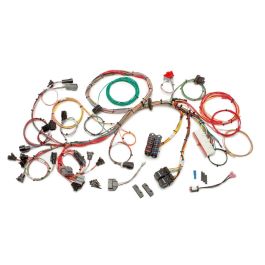EFI. I took the manifold off to make it easier to install. Three questions I have now is 1) are there any restrictions for headers on the '99 302? The passenger side has a PCV pipe with a couple vacuum lines. 2) I am going to use the wiring harness out of the Explorer including the computer. It will have many wires not needed (door locks, electric mirrors, rear window defrost, etc., etc.). Can I just truncate them without any problems? 3) Is there a way to eliminate the O2 sensors? Any input is appreciated.
For above: 1) follow advice of
@CDW6212R for header info. I'm "way earlier" in that respect. 2) Beware that certain functions you do not need are tied into the PCM for safety considerations. If you expect to utilize full EFI operation, and wind up with ABS requirement, that function is capable of "shutting you down" under certain circumstances. Two specific codes do it: "Forced Engine Idle", and "Forced Engine Shutdown". This happened to me, took LOTS of perseverance to sort it out.
The two main Ford EFI schemes are EEC-IV, used until 1995, EEC-V used thereafter. IV is MUCH more agreeable to modifications without dire things resulting. I used it exclusively in converting carburreted engines to EFI, with good results. I recommend strongly you get a copy of Charles Probst's book, "Ford Electronic Fuel Injection". It got me through many headaches.
EEC-IV uses one 02 sensor per bank of cylinders, making for good operation. The EGR function is easily blocked off without dire results. IV used a smog pump, easily deleted. Both kinds of air volume measurement were used: Speed Density, and Mass Air. Speed Density
estimates the air volume entering the engine, based on it's size and speed (and relative humidity, barometric pressure, etc.); far better is Mass Air, which actually measures the amount of air flowing. Speed Density is very fussy about engine modifications; Mass Air allows even supercharging, it will handle it. Both were used, from late '80s on. Mustangs got Mass Air in 1989, but certain other applications, notably F-Series trucks, continued with Speed Density. Consult with Probst for details.
EEC-V brought in OBD-II, On Board Diagnostics II in 1996, which complicated matters. Many will argue with me on this. Which way you go will be your call.













